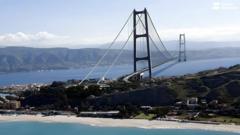The Italian government has officially approved a transformative €13.5 billion ($15.6 billion) initiative to construct the world’s longest suspension bridge, linking the island of Sicily to Calabria, a region at the tip of Italy's boot. The ambitious project, designed to endure the seismic activity of the Mediterranean, aims to enhance connectivity and support economic growth in one of Europe’s poorest areas.
Prime Minister Giorgia Meloni acknowledged the difficulties faced in advancing the Messina Bridge plan, admitting the challenges are significant but viewing them as necessary for Italy's future. The project entails a bridge that stretches 3.3 kilometers (2.05 miles) across the Messina strait, supported by two towers standing 400 meters (1,300 feet) tall, with provisions for two railway lines and three lanes of road traffic.
Transport Minister Matteo Salvini, a Meloni ally, expressed optimism that the bridge could be completed between 2032 and 2033, predicting the creation of 120,000 jobs annually and the economic revitalization of the regions of Sicily and Calabria. The Italian government is also pushing for the bridge to be considered a military expenditure, contributing towards NATO's 5% GDP defense spending target.
However, several procedural steps remain before construction can begin, including approvals from the Italian Court of Auditors and environmental agencies at both national and EU levels. Concerns among local communities about property expropriation and potential legal challenges could further delay the project.
There has been a long history of opposition to the bridge, mainly due to fears about corruption and mismanagement of taxpayer funds, particularly regarding the potential involvement of mafia groups in southern Italy. Local politicians and grassroots movements have expressed dissatisfaction, with concerns voiced about resource diversion from essential services such as transportation, healthcare, and education.
As the region faces ongoing water scarcity issues, opponents argue that the bridge's construction would exacerbate local challenges. Presently, the sole means for trains to traverse the strait involves shuttling carriages on ferries, a journey taking approximately 30 minutes.
Prime Minister Giorgia Meloni acknowledged the difficulties faced in advancing the Messina Bridge plan, admitting the challenges are significant but viewing them as necessary for Italy's future. The project entails a bridge that stretches 3.3 kilometers (2.05 miles) across the Messina strait, supported by two towers standing 400 meters (1,300 feet) tall, with provisions for two railway lines and three lanes of road traffic.
Transport Minister Matteo Salvini, a Meloni ally, expressed optimism that the bridge could be completed between 2032 and 2033, predicting the creation of 120,000 jobs annually and the economic revitalization of the regions of Sicily and Calabria. The Italian government is also pushing for the bridge to be considered a military expenditure, contributing towards NATO's 5% GDP defense spending target.
However, several procedural steps remain before construction can begin, including approvals from the Italian Court of Auditors and environmental agencies at both national and EU levels. Concerns among local communities about property expropriation and potential legal challenges could further delay the project.
There has been a long history of opposition to the bridge, mainly due to fears about corruption and mismanagement of taxpayer funds, particularly regarding the potential involvement of mafia groups in southern Italy. Local politicians and grassroots movements have expressed dissatisfaction, with concerns voiced about resource diversion from essential services such as transportation, healthcare, and education.
As the region faces ongoing water scarcity issues, opponents argue that the bridge's construction would exacerbate local challenges. Presently, the sole means for trains to traverse the strait involves shuttling carriages on ferries, a journey taking approximately 30 minutes.




















